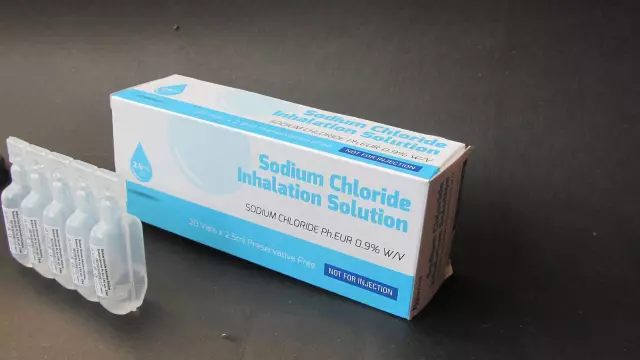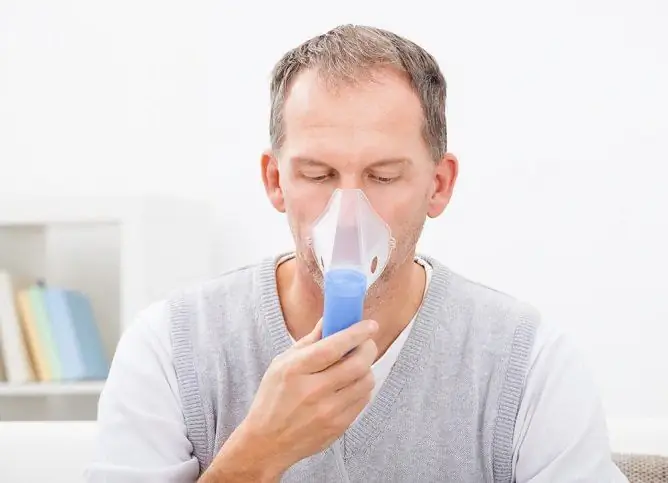- Author Rachel Wainwright [email protected].
- Public 2023-12-15 07:39.
- Last modified 2025-11-02 20:14.
Ambrohexal
Ambrohexal: instructions for use and reviews
- 1. Release form and composition
- 2. Pharmacological properties
- 3. Indications for use
- 4. Contraindications
- 5. Method of application and dosage
- 6. Side effects
- 7. Overdose
- 8. Special instructions
- 9. Application during pregnancy and lactation
- 10. In case of impaired renal function
- 11. For violations of liver function
- 12. Drug interactions
- 13. Analogs
- 14. Terms and conditions of storage
- 15. Terms of dispensing from pharmacies
- 16. Reviews
- 17. Price in pharmacies
Latin name: AmbroHEXAL
ATX code: R05CB06
Active ingredient: Abmroxol Hydrochloride
Producer: GmbH Salyutas Pharma, Germany
Description and photo update: 2019-12-08
Prices in pharmacies: from 80 rubles.
Buy

Ambrohexal is an expectorant and mucolytic medication used in the treatment of respiratory diseases.
Release form and composition
The drug is released in the form:
- Round white tablets containing 30 mg of ambroxol hydrochloride and excipients: lactose monohydrate, calcium hydrogen phosphate dihydrate, corn starch, sodium carboxymethyl starch, magnesium stearate, colloidal silicon dioxide. In blisters of 10;
- Long-acting hard gelatin capsules containing 75 mg of ambroxol hydrochloride and auxiliary substances: microcrystalline cellulose, eudragit RL30D and RS30D, triethyl citrate, magnesium stearate, titanium dioxide, iron oxide red dye. In blister packs of 10;
- A colorless solution for inhalation and ingestion containing 1 ml (1 ml = 20 drops) of 7.5 mg ambroxol hydrochloride and auxiliary substances: methyl parahydroxybenzoate, propyl parahydroxybenzoate, sodium disulfite, citric acid, sodium hydroxide, water. In dropper bottles of 50 ml;
- Yellowish syrup containing 3 or 6 mg of ambroxol hydrochloride and auxiliary substances in 1 ml: benzoic acid, sodium disulfite, citric acid monohydrate, sodium hydroxide, povidone, sorbitol 70% solution, glycerol 85%, sodium cyclamate, raspberry flavor, purified water. In dark bottles of 100 ml with a measuring spoon.
Pharmacological properties
Pharmacodynamics
Ambroxol - the active component of Ambrohexal - is characterized by expectorant, secretolytic and secretomotor action. It stimulates the serous cells of the glands located in the bronchial mucosa, increases the production of mucous secretions and enhances the release of a surfactant (surfactant) in the bronchi and alveoli. Ambroxol also normalizes the disturbed balance of the mucous and serous components of sputum and reduces the viscosity of the sputum, activating the enzymes responsible for hydrolysis and promoting the release of lysosomes from Clara cells. This compound intensifies the motor activity of the ciliated epithelium, activates mucociliary transport and facilitates the process of removing sputum from the respiratory tract.
Usually, the therapeutic effect with oral administration of Ambroxol is observed after 30 minutes and lasts 6-12 hours, depending on the size of the dose taken.
Pharmacokinetics
When taken orally, Ambroxol is absorbed quickly and almost completely. The maximum concentration of the substance in this case is reached within 1-3 hours after ingestion.
Ambroxol is metabolized in the liver, forming metabolites excreted in the urine (glucuronides, dibromantranilic acid). It binds to plasma proteins by about 85%. The plasma half-life is 7-12 hours. The total half-life of ambroxol and its metabolites is approximately 22 hours. 90% of the compound is excreted through the kidneys as metabolites. Less than 10% of ambroxol is excreted unchanged in the urine.
Since ambroxol binds to proteins to a large extent and has a large volume of distribution, and is also characterized by a slow reverse penetration from tissues into the blood, forced diuresis or dialysis does not significantly affect its excretion. In patients with severe hepatic dysfunction, ambroxol clearance decreases by 20-40%. In severe renal failure, the half-life of ambroxol metabolites increases. Also, the substance easily penetrates the placental barrier and into breast milk.
Indications for use
Ambrohexal is prescribed for treatment:
- Acute and chronic diseases of the respiratory tract, characterized by the formation of a viscous secretion;
- Bronchial asthma with difficulty in sputum discharge;
- Chronic obstructive pulmonary disease;
- Pneumonia;
- Acute and chronic bronchitis;
- Bronchiectasis.
Ambrohexal syrup and solution for oral administration and inhalation is also used to treat and prevent respiratory distress syndrome.
Contraindications
- First trimester of pregnancy;
- Hypersensitivity to the active substance (ambroxol) and auxiliary components of the drug.
According to the instructions, Ambrohexal in the form of tablets is allowed from 6 years old, capsules - from 12 years old.
With care, the medication is prescribed by lactating women, as well as against the background:
- Peptic ulcer and 12 duodenal ulcer (due to the risk of possible exacerbation of the disease);
- Renal and hepatic failure.
Instructions for the use of Ambrohexal: method and dosage
Ambrohexal syrup for children after 12 years of age and for adults is prescribed 3 times a day, 2 scoops (30 mg). The maximum is 120 mg per day. After improving the condition, it is recommended to reduce the frequency of admission to 2 times a day.
For children, syrup is used according to the following scheme:
- Children 6-12 years old - one measuring spoon 2-3 times a day;
- Children 2-5 years old - 0.5 scoops 3 times a day;
- Children under two years old - 0.5 scoops 2 times a day.
Children from 12 years old and adults are prescribed 1 tablet of Ambrohexal 3 times a day for the first few days of treatment, after which the frequency of use must be reduced to 2 times a day. A single dosage for children 6-12 years old is 1/2 tablet.
Capsules are taken after meals in the morning or evening. The daily dosage for adults and children over 12 years old is 1 capsule.
Solution for oral administration and inhalation Ambrohexal is usually prescribed 3 times a day, 4 ml (30 mg). After improving the condition, the frequency rate is reduced to 2 times a day. For children 5-12 years old, the maximum daily dose of the drug in this dosage form is 45 mg, divided into several doses, for children 2-5 years old - 15 mg. The solution is taken after meals by adding it to tea, fruit juice, milk or water.
Inhalation with Ambrohexal solution is shown up to 2 times a day. A single dosage for all age groups is 2-3 ml.
The duration of treatment is determined by the doctor individually, depending on the indications and the severity of the disease. Doctor's supervision is necessary when taking the drug for more than 4-5 days.
Side effects
The drug can cause:
- Hives;
- Contact allergic dermatitis;
- Skin rash;
- Angioneurotic edema;
- Anaphylactic shock;
- Dry mouth;
- Diarrhea;
- Headache;
- Weakness;
- Nausea;
- Vomiting;
- Rhinorrhea;
- Constipation;
- Gastralgia.
When using ambroxol in high doses, nausea, diarrhea, vomiting, and dyspepsia may also occur. For treatment, they induce vomiting, wash the stomach, consume fat-containing foods.
Overdose
Overdose symptoms include increased salivation (when taking 6 mg / ml syrup), dyspepsia, nausea, vomiting, gastralgia, diarrhea. It is recommended to immediately stop taking the drug, induce artificial vomiting and flush the stomach during the first 1-2 hours after the drug enters the body. The use of fat-containing foods and symptomatic therapy will also help improve the patient's condition.
special instructions
Caution requires the use of Ambrohexal against the background of a weakened cough reflex or disorders of mucociliary transport, since there is a risk of sputum accumulation.
Against the background of severe impairment of liver or kidney function, the use of lower concentrations of Ambrohexal or an increase in the interval between doses of the medication is indicated.
The use of the medication before bed is not recommended.
Against the background of bronchial asthma, Ambrohexal can increase coughing.
During drug therapy, breathing exercises are not recommended. Against the background of a severe course of the disease, it is necessary to perform aspiration of liquefied sputum.
Influence on the ability to drive vehicles and complex mechanisms
According to the instructions, Ambrohexal does not adversely affect the ability to drive and work with mechanisms of increased complexity.
Application during pregnancy and lactation
Ambrohexal is prohibited for use in the first trimester of pregnancy. Its appointment in the II and III trimesters is allowed if the possible benefits of treatment for the mother significantly outweigh the potential risks to the fetus.
Ambroxol easily penetrates the placental barrier. The results of experiments on animals have confirmed that the drug has no significant effect on embryo-fetal and postnatal development, as well as childbirth. The active component of the drug is excreted in small quantities in breast milk, therefore, during treatment, it is necessary to consider the feasibility of stopping breastfeeding.
With impaired renal function
Ambrohexal is prescribed with caution in renal failure. In severe renal dysfunction, it is recommended to switch to lower concentrations of the drug or to increase the interval between doses.
For violations of liver function
Ambrohexal should be used with caution in liver failure. In severe disorders of liver function, the dose of the drug should be reduced or the interval between doses should be increased.
Drug interactions
When Ambrohexal is combined with other antitussives (including codeine) against the background of suppressing cough, it may be difficult to pass sputum.
The drug increases the degree of penetration into the bronchial secretions of erythromycin, amoxicillin, doxycycline, cefuroxime.
Analogs
The following drugs are analogs of Ambrohexal:
- According to the active substance - Ambrobene, Flavamed, Ambroxol, Halixol, Bronchoxol, Bronchorus, Ambrolor, Neo-Bronchol, Lazolvan, Medox, Lazongin, Remebrox;
- According to the mechanism of action - Cashnol, Joset, Fluifort, Bromhexin, Ascoril, Acestin, ACC, Acetylcysteine, Bronchobos, Fluditek, Erdomed, Bronhotil, Muconex, Sinupret, Solvin, Pulmozyme, Fluimucil, Bronchostop.
Terms and conditions of storage
The shelf life of tablets is 5 years, capsules and syrup - 3 years, solution for inhalation and ingestion - 4 years.
Store in a dry, dark place at a temperature not exceeding 25 ° C.
Terms of dispensing from pharmacies
Available without a prescription.
Reviews about Ambrohexal
According to reviews, Ambrohexal in the form of tablets is very well tolerated and demonstrates high efficiency in the treatment of severe dry cough. There are practically no side reactions during treatment with the drug. Many patients like it because of its low cost and its availability. The syrup has the same pharmacological properties and attracts patients with a pleasant sweetish taste. Usually, a week after the start of therapy, the cough disappears in most patients without a trace.
Inhalation with Ambrohexal solution also has positive reviews. The main advantages of the drug are considered to be the variety and convenience of the release forms, acceptable treatment results and quick recovery against the background of its use. Parents note that inhalations with Ambrohexal and saline solution help to relieve children from painful coughing attacks in the shortest possible time. However, there are references to the unpleasant taste of this dosage form.
Price for Ambrohexal in pharmacies
The average price of Ambrohexal tablets in most pharmacies is 109-117 rubles (the package includes 20 pcs.). Ambrohexal syrup with a dosage of 3 mg / ml can be purchased for 93-112 rubles, and with a dosage of 6 mg / ml - for 205-229 rubles (for a 100 ml bottle). The solution for inhalation and ingestion costs about 89-102 rubles (for a bottle of 50 ml). Sustained-release capsules are currently not on sale.
Ambrohexal: prices in online pharmacies
|
Drug name Price Pharmacy |
|
AmbroHexal 3 mg / ml syrup 100 ml 1 pc. RUB 80 Buy |
|
AmbroHexal 30 mg tablets 20 pcs. RUB 86 Buy |
|
Ambrohexal tablets 30mg 20 pcs. RUB 88 Buy |
|
Ambrohexal syrup 3mg / ml 100ml 114 RUB Buy |
|
AmbroHexal 6 mg / ml syrup 100 ml 1 pc. 177 r Buy |

Maria Kulkes Medical journalist About the author
Education: First Moscow State Medical University named after I. M. Sechenov, specialty "General Medicine".
Information about the drug is generalized, provided for informational purposes only and does not replace the official instructions. Self-medication is hazardous to health!






